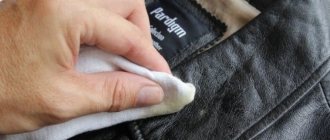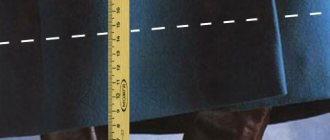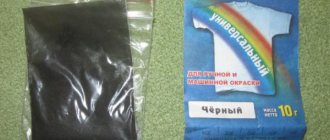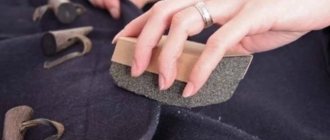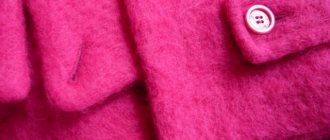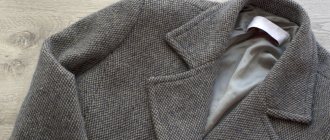Cashmere is a fine, expensive wool fabric that looks very elegant, luxurious and stylish. A cashmere coat will never go out of style due to its attractive appearance. In addition, it effectively protects against cold and wind.
However, over time, any fabric becomes dirty and requires cleaning. As a general rule, cashmere coats should not be washed. But even if the label on the clothing allows machine or hand washing, after the procedure the material may wrinkle and lose its attractive appearance.
And after several washes, the coat loses its shape and becomes deformed. Therefore, it is better to clean your coat using dry methods. Let's find out how to clean a cashmere coat at home.
Cleaning Methods
If the icons on the label “allow” washing, you can do it, but in general, dry cleaning a cashmere coat is preferable to soaking the entire product, especially spinning it in the washing machine. The cleaning method is chosen depending on the degree and type of contamination:
- You can try to remove fresh stains on a completely clean coat yourself using a store-bought stain remover or home methods;
- Clean slightly greasy areas on the sleeves, collar and the entire item, if it is not very dirty, with one of the special dry cleaning products;
- If the coat requires washing, follow the label directions exactly.
Dry cleaning
Treating cashmere with chemical and natural dry cleaning products allows you to neutralize stains without using water. The advantage of such methods is that the fabric is not even minimally deformed, as happens with active washing. Dry cleaning can be:
- manual;
- machine (for this, the automatic washing machine must have a drying function).
If you are using any of the cleaning products for the first time, test its effect on a small piece of fabric from the inside of the coat. Of the industrial preparations for home manual cleaning, the following have gained popularity due to their effectiveness and convenience:
Sano Spot Remover spray (Israel) - from stains of grease, sweet drinks, coffee. Spray the product from the can onto the stain from a distance of 20–25 cm. Wait about half an hour until it dries completely and clean with the brush included in the kit (located on the cap).
Spray K2R (Austria) - will remove greasy and oily stains of any origin. The technology of use is similar to the one above.
Aerosols for dry cleaning have a strong unpleasant odor, and when dried, they turn into fine dust when removed, so it is better to carry out cleaning work in the fresh air.
Special products have been created for dry machine cleaning of items made from fabrics that require careful handling, including cashmere coats. In particular, Hagerty Dry Cleaner Kit (France), Dryel (USA) are kits that include:
- a cloth soaked in an activated cleaning solution;
- bag for things;
- a product for treating stains before cleaning (the Hagerty Dry Cleaner Kit includes a special cloth impregnated with a cleaning solution; the Dryel kit includes a spray bottle).
After inspecting the coat and treating it from dirt:
- Place it together with the cleaning cloth in a special safety bag, seal it tightly according to the instructions and place it in the drum of the washing machine.
- Set the drying temperature (heat) to its minimum, and the drying time to 15 minutes to simply refresh the item, and 30 minutes to clean your cashmere coat more thoroughly.
- After completing the procedure, remove the coat from the bag, shake it and hang it on soft hangers, straightening out the folds.
- Throw away the cleaning cloth and use the protective bag up to 20 times.
After such dry automatic cleaning, a coat can be put on almost immediately, its humidity is minimal, it is more like the freshness of a clean product.
You can also use home remedies to remove some stains:
- Purified gasoline "Galosha" is a quick way to remove greasy stains. Apply a little product to the stain and cover it with baby powder on top. After the fragment has completely dried, carefully clean off the powder with a soft brush.
- Soap with ammonia is a good remedy for cleaning shiny areas (collars, sleeve cuts), which are especially visible on light-colored items. Moisten a piece of cotton wool with a solution of baby shampoo or a special product for cashmere and rub the dirty area with it. Soak a second piece of cotton wool with ammonia and blot the area moistened with soapy water with it. Use a clean, absorbent, damp cloth to remove all remaining substances from the surface of the coat.
- Ammonia with glycerin is an effective method for removing stains of any origin and will clean heavily soiled areas. Mix the ingredients in equal parts and apply to the stains using a cotton pad. After five minutes, repeat the procedure, and after another two minutes, remove the remaining mixture with a damp soft sponge.
Remove small crumbs, dust, hairs, and hair from the surface of a cashmere coat with sticky rollers for clothes.
Wet cleaning
The easiest way to wet clean a cashmere coat is to steam it. Some washing machines have this new feature. Clothes placed in the drum do not come into contact with water at all. The liquid turns into steam using a built-in steam heater. You can also use a portable steam generator.
For washing, use special products for cashmere, such as Wellery ECO (Russia), Woolite (Russia), Laundress Wool & Cashmere (USA), Domol (Germany). Hand wash your items as follows:
- Dilute the detergent in cold water and soak the coat.
- Easily wipe the most contaminated areas with a sponge or your hands.
- Rinse the coat well in clean water and wring it out slightly without twisting.
If the label states that your cashmere coat is machine washable:
- Select the most delicate mode without spin with a water temperature of no higher than 30 °C.
- Immediately after washing, remove the clothes from the washing machine drum.
If it is not possible to use special liquid detergents for washing cashmere, any least alkaline hair shampoo will do.
First steps
Before cleaning, you should carefully study the product tag. It indicates the permitted methods of caring for the item, temperature conditions and recommended cleaning agents.
Next, carefully inspect the coat. Hang the product on hangers, examine both the front side and the inside. Pay special attention to the collar, pockets, and armpit area. It is advisable to perform this procedure in daylight, so you will not miss a single spot or unsightly stain on the fabric.
Depending on the degree of soiling of your cashmere coat, choose the appropriate cleaning method for the product. They are as follows:
How to clean a light cashmere coat
Through experience, skillful housewives have adapted to cleaning white cashmere outerwear with Vanish carpet cleaner. Use the drug in powder form or in a spray:
- Apply the product evenly to the surface of the coat, if necessary, foaming first.
- Remove Vanish residue with a vacuum cleaner using a clean attachment.
This is a fairly drastic method of dry cleaning cashmere, so be sure to try it on an inconspicuous area on the inside of the coat.
Eliminates odor and sweat stains
Wipe the coat in the armpit area with a cloth soaked in soapy water. It’s easy to make: dissolve regular soap in warm water or add shampoo. Next, you will need to wet a cotton swab with ammonia and wipe the previously treated areas. By the way, this method removes not only the smell, but also sweat stains.
Another option is to use a mixture of vinegar and glycerin. The components are taken in equal parts. Apply the prepared product to the contaminated area. After 20 minutes, remove with a damp cloth.
Drying and care rules
After squeezing it a little, lay the cashmere coat to dry on a large towel, straightening out all the details. Fold the towel so that the item is inside and squeeze lightly. Repeat this procedure several times, transferring the coat to dry towels. When it becomes slightly damp, leave it on another dry towel, preferably laying it on top of a home folding dryer to allow ventilation from all sides. When clothes are almost dry, hang them on soft or inflatable hangers.
To ensure that your cashmere coat retains its special appearance and properties longer, follow some rules when caring for it:
- do not wear - delicate cleaning or washing may not remove old dirt;
- do not iron cashmere items; in extreme cases, lightly steam without touching the iron to the fabric;
- use trempels with voluminous hangers so that outerwear stretches less.
Cleaning a cashmere coat yourself at home is not easy and quite troublesome. However, this way an expensive, high-quality item will be preserved better than after numerous procedures at dry cleaning or regular washing. With such careful treatment, our unique
Removing stains from cashmere
We offer the most proven and effective ways to combat various types of pollution:
Fat marks
Talc will help remove them. Sprinkle it on the dirty area, rub a little into the fibers of the fabric and leave for half an hour. During this time, the talc will absorb the fat, all you have to do is brush it off. Repeat the procedure if necessary.
There is another way. Moisten a soft sponge, drop a little dishwashing gel on it, and whip up some foam. Wipe the grease stain with a sponge. After 5 minutes, use a clean damp cloth to remove any remaining detergent and dry the product with paper towels.
Old stains
Place a paper towel on the contaminated area from the front side of the product. Soak a cotton swab in gasoline and wipe the contaminated area from the inside of the coat. Use a damp sponge to remove any remaining gasoline.
All types of pollution
The following remedy is considered universal. It will help remove contaminants whose origin you know nothing about. Take glycerin and the same amount of ammonia, mix. Wipe the contaminated area with the resulting mixture, do this several times. Remove any remaining substance with a damp cloth.
Fresh stains from drinks and food
Take finely ground salt and sprinkle it on the stain. After the salt has absorbed the dirt, clean the coat with a soft brush.
Features of cleaning a drape coat
Due to the fact that the drape is a two-layer woolen fabric, the use of classic washing is not recommended.
The material will simply shrink and the item will deteriorate. The exception is products containing a sufficient amount of artificial fibers. As a rule, information about this can be found on the label. Therefore, all that remains is to hand over the coat to a professional dry cleaning establishment. You can also try to carry out the cleaning procedure yourself, taking precautions
To clean a drape coat without washing and preserve its external and functional characteristics, you must consider the following recommendations:
- Carefully read the information on the label. It must indicate acceptable cleaning and maintenance methods.
- Inspect the coat, first hanging it by the shoulders, for dirt in vulnerable places - on the collar, sleeves, cuffs.
- Test the effect of the cleaning agent on an inconspicuous part of the coat. If the recipe turns out to be harmful, this will avoid damage to the product.
- When cleaning, dirt should be removed from the drape material strictly in the direction from the center to the periphery. This will get rid of stains and streaks.
- You can prevent your coat from getting wet during wet cleaning by placing moisture-absorbing material under its lining.
- It is best to get rid of minor dirt in the form of small stains, lint, threads using a soft brush for gentle fabric.
- To clean the coat from heavy dirt, you must first use a dry brush, and then a damp brush with rounded bristles.
Regardless of the chosen technique and method, it is permissible to clean drapery material only by the pile.
Cleaning Features and Precautions
Cleaning a coat depends on the material from which it is made. However, for almost every type there are a number of general requirements that must be adhered to. You should carefully choose the product that will be used to subsequently clean the product.
You should not use aggressive chemicals for such purposes, which can damage not only the delicate material that requires delicate handling, but also the skin of your hands. If you are not sure whether a cashmere coat can be washed with the chosen product, it is recommended to test the substance on a small, inconspicuous area of the product. Only after checking the reaction of the material to the selected drug should it be cleaned.
In case of severe contamination, only dry cleaning can help get rid of dirt. If it is not possible to remove stains at home using folk remedies, then you should contact specialists who will cope with the stains.
General recommendations for cleaning coats
Before you start cleaning your coat yourself, you need to clearly define the scope of work and select the necessary means and methods. Simple recommendations will help you quickly decide on this issue and carry out cleaning without harming the product:
First of all, carefully study the label. A small label can immediately throw away a lot of questions. The material from which the coat is made plays a decisive role in choosing the cleaning method. Most modern manufacturers use a mixed fabric composition. In this case, rely on the percentage of natural components (wool, cotton, linen, silk)
Natural materials require more delicate cleaning than synthetic ones.
Pay attention to other useful information: can the product be washed (including in an automatic machine) and at what temperature, how to iron it, dry it, whether dry cleaning is allowed.
Consider the color of the coat. Methods that are suitable for removing stains from white material may ruin dark or colored items.
Plain coats are easier to clean than mixed coats (especially if they are contrasting colors). In this case, before cleaning, you should definitely check whether the fabric is fading. Pay attention to the presence of decorative elements. Embroidery, rhinestones, beads and other decorations make it impossible to use some heat treatments when cleaning. If the product has sewn or removable decorative elements, it is better to remove them from the coat before starting the procedure. Inspect the coat in detail before cleaning. Try to accurately determine the type of contamination. Traces of paint, food, blood, etc. require a different approach.
Table: names of materials on labels in English and translation
| Title in English | Translation |
| cotton | cotton |
| elastane | elastane |
| lace | lace |
| leather | leather |
| linen | (linen |
| nylon | nylon |
| polyester | polyester |
| silk | silk |
| wool | wool |
How to remove pills from a polyester coat?
How to remove pills from polyester
- 2.1 First method: shaving machine
- 2.2 Second method: roller with adhesive tape or wide stationery tape
- 2.3 Third method: using a toothbrush
- 2.4 Method four: use scissors
- 2.5 Fifth method: use dry cleaning services
- 2.6 Sixth method: use a special machine
12 Dec.
2022 Interesting materials:
How to wash floor tiles without streaks? How to wash the upholstery of a sofa? How to wash balcony windows from the outside? How to wash windows without streaks at home? How to wash windows without streaks? How to clean the sliding windows on the balcony from the outside? How to wash panoramic windows from the outside? How to wash plastic windows from the outside? How to wash a ceiling painted with water-based paint? How to wash roller blinds?
We take into account the manufacturer’s advice
At first glance, the easiest option is to go to a dry cleaner. But it is not always possible to use the services of professionals. For example, you are not satisfied with the price or timing, because it happens that a coat needs to be cleaned of dirt urgently. Therefore, this can be done at home. The main thing is to take all precautions and not experiment with unfamiliar chemicals.
First you need to carefully study the label, which contains important information. Use the manufacturer’s advice: what temperature should the water be, is it possible to use a washing machine, how to iron and dry the product. Don't neglect this information. Proper care will keep your item in its original form for a long time.
How to clean
It is recommended to clean a wool coat, avoiding over-wetting the material. Because of this, the item will stretch and will not return to its original shape. However, in some cases you have to resort to wet cleaning. When rubbing areas with dirt, you need to move from the center to the edges. Thanks to this, after cleaning, streaks will not appear on the wool coat.
Wet cleaning
Wet cleaning is used to remove stains. In this case, the following algorithm is used:
- Washing powder (or liquid soap) is mixed in a container.
- A rag or sponge is moistened in the resulting solution, which is then used to rub the contaminated areas.
- After 30 minutes, the soap solution is removed with a dry cloth (it is recommended to use a microfiber cloth).
- The coat is left on hangers until completely dry.
If complex stains are found on a woolen coat, then other methods are used. Traces of engine oil are removed using gasoline, in which you need to soak a cotton pad and treat the contaminated area from the back side, pressing a paper towel on top (removes excess fuel). A glycerin solution helps get rid of traces of coffee or tea. The latter should be applied to the contaminated area and wait until it dries completely.
Cleaning a wool coat from greasy stains is carried out using a solution of vinegar and alcohol. You need to moisten a cotton pad in this mixture and treat the marks. Then the coat should be left for 15 minutes, after which a soft cloth should be rubbed over the dirty area.
Dry cleaning
To remove grease stains, you can use two traditional methods. The first is applied immediately after the formation of marks. In this case, you will need to apply talc or starch to the fur stain, cover with paper or a thin cloth and leave for 6–10 hours. After the allotted period, the remaining powder is removed with a brush.
For the second method, you will need to mix 10 ml of 10 percent ammonia and 40 g of salt. The powder, which has absorbed the liquid, then needs to be rubbed into the greasy areas. After removing dirt, remaining salt can be removed with a brush.
If the type of contamination cannot be determined, then in this case it is recommended to use a mixture of ammonia and liquid soap, taken in a 1:2 ratio. You need to moisten a cotton swab in the resulting solution and apply it to the problem area. If the stain appeared a long time ago, then you need to wait a few minutes. Finally, wipe off the dirt with a damp cloth.
Removing stains
Fresh stains are always easier to remove
If even after washing the stains do not come out, this situation is very frustrating. Fortunately, there are folk recipes for remedies that remove stubborn stains.
Fat
A mixture of ammonia, water and liquid soap can deal with stagnant grease stains. In some cases, you can use a cloth soaked in gasoline to remove dirt.
If the stain is fresh, then it is covered with starch, talcum powder or fine salt. The product is applied in a thick layer and left for several hours, or better yet, overnight. It will absorb dirt, after which the fabric is cleaned.
Dirt
To remove dirt on the collar or cuffs, you can use a mixture of salt and ammonia in a ratio of 4:1.
Coffee
Coffee stains will disappear if you treat the fabric with a simple mixture that you can prepare at home. Two tablespoons of glycerin are mixed with one spoon of ammonia. These drugs can be purchased at a pharmacy.
Some cleaning rules will help remove stains efficiently:
- You need to treat the stain with gentle movements, moving from the edges to the center. If you start with it and remove it it will be harder.
- In order not to stain the lining, it should be slightly torn off and a clean cloth should be placed under the stain to be removed, which will absorb excess liquid and dirt.
- It is better to process the fabric from the wrong side.
Modern stain removers can cope with any problem, but if you cannot remove the stain at home, it is better to seek help from professional dry cleaning specialists.
Dry but don't iron
After this, the cashmere product is carefully wrapped in a terry towel and lightly squeezed, without twisting too much. Then place it on the table, lay it down with a dry towel, straighten it and leave it until completely dry. You cannot dry your coat on a radiator.
Ironing a cashmere coat is not recommended. It's better to use steam. But if such a need arises, you need to control that the temperature does not exceed 200 degrees. Do not allow the front side to come into contact with the iron. Ironing can only be done from the inside out or through the fabric.


